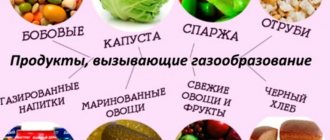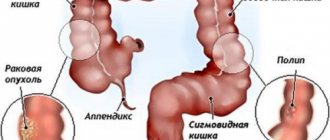Flatulence (from the Greek word meaning rising, bloating) is an excessive formation, accumulation of gases in the lumen of the digestive tract. A healthy person's gastrointestinal tract contains about 200 ml of gases. The gases include a mixture of hydrogen, methane, nitrogen, sulfur, and carbon monoxide.
Bloating is a common and unpleasant symptom that sometimes causes a person to suffer more than abdominal pain. Bloating is a subjective sensation of excess gas in the gastrointestinal tract; it is included in the medical concept of flatulence syndrome.
Causes of flatulence
Aerophagia
Normally, when eating food and liquid, or swallowing saliva, a small amount of air enters the stomach. But often there is increased swallowing and swallowing more air:
- when eating in a hurry (fast food),
- when talking while eating,
- smoking,
- drinking carbonated drinks,
- drinking through a straw,
- using chewing gum
- with poorly fitting dentures,
- some mental states (anxiety, hysterical psychoses).
Lack of enzymes in the gastrointestinal tract
The lack of enzymes leads to the fact that a large amount of undigested food debris ends up in the lower parts of the digestive tract. The processes of rotting and fermentation are activated there. During fermentation processes, sudden gas formation , bloating, rumbling, transfusion, and increased release of gases (carbon dioxide and methane) are observed. This is most often observed after eating plant foods, milk, and rye bread.
Putrefactive processes ( dyspepsia ) develop with excessive consumption of food proteins due to enhanced enzymatic digestion of them. Flatulence is less pronounced, but the gases released are more smelly due to hydrogen sulfide and ammonia.
In the formation of carbon dioxide, the level of hydrochloric acid in the stomach and the activity of pancreatic secretions, enzymatic deficiency (intolerance to lactose, fructose, wheat) are important.
A larger amount of gases is represented by intestinal gases (up to 75%). They are formed during the enzymatic activity of intestinal bacteria during the digestion of food components.
In the small intestine, small gas bubbles mix with food. Only 20% of gases are of bacterial origin.
In the colon, gases are 100% formed by bacteria, and due to the high density of the contents in the intestine, the processes of penetration of gases into the blood are disrupted. This creates conditions for the accumulation of large amounts of gases.
A healthy person can release from 0.5 to 1.5 liters of gases per day. The “food” for colon bacteria is digestible fiber - cellulose, hemicellulose, pectins, dietary fiber. Under normal conditions, large amounts of gases are absorbed by bacteria (aerobes), which also live in the large intestine. A violation of the ratio of bacteria that produce gas and bacteria that absorb it causes flatulence.
Gases produced by microflora are involved in the regulation of intestinal function, for example, methane helps slow down peristalsis and causes constipation, and carbon dioxide regulates the peristalsis of the colon, increasing peristalsis.
Malabsorption of food components
Bloating can be observed with increased gas formation in diseases in which the absorption of food components is impaired, in violation of the microbiome of the small and large intestines, gluten intolerance and lactase deficiency, and in the consumption of problematic foods that cause increased gas formation.
Impaired colon motility, constipation and increased sensitivity to stretching of the intestinal wall (visceral sensitivity in IBS and functional diseases) can interfere with the passage of gases and their retention in the intestinal lumen.
Abdominal bloating occurs occasionally in all people and is most often associated with dietary habits and the consumption of “problem” foods.
Why is there constant bloating?
If abdominal discomfort persists for a long time, then this is a serious reason to contact a therapist and gastroenterologist. Constant bloating is an alarming symptom, indicating the presence of pathology of the digestive system. Particular concern should be caused by the fact of malaise against the background of normalization of nutrition and the abandonment of bad eating habits.
In diseases of the digestive system, bloating is accompanied by a set of other symptoms: severe pain, weakness, nausea, heartburn, diarrhea or constipation.
Foods that cause flatulence
Products that most often cause increased gas formation:
- legumes of all types (white, red, brown), lentils of all types,
- all types of cabbage (white cabbage, broccoli, Brussels sprouts, kohlrabi, cauliflower),
- salads of all kinds,
- dairy products,
- onion,
- celery, parsley,
- garlic,
- asparagus,
- beets, carrots,
- bananas,
- raisin,
- grapes, apricots, plum juice, apples, plums,
- yeast bread (black, bagels, fresh bread, especially wholemeal bread), wheat germ,
- beer,
- nuts (pistachios and sesame),
- soybeans and soy products (tofu, soy milk).
These foods contain a lot of fermentable fructo-oligosaccharides - these are sugars that, when they enter the large intestine, begin to be intensively digested and form gases - wheat products, fruits rich in fructose (e.g. apples, pears), vegetables containing fructans (e.g. onions, asparagus ), products containing raffinose (e.g. legumes, beets), sorbitol (sugar-free chewing gum). Oats and potatoes can potentially cause flatulence because... rich in carbohydrates (sugars, starch).
The microbial composition of the intestine and peristalsis depend on the amount of polysaccharides consumed. Depending on the nature of the intestinal flora and the clinical picture of the disease, gas formation in the intestines is distinguished as fermentative, putrefactive and mixed.
All of them cause psychological discomfort and reduce a person’s quality of life.
Prevention
Normalizing your diet and healthy lifestyle will help you avoid attacks of flatulence (Fig. 4).
Basic principles of prevention:
- eat often, but in small portions;
- pay attention to physical activity;
- monitor your weight;
- give up carbonated drinks;
- do not chew gum or eat on the go;
- drink more plain clean water;
- include fermented milk products with prebiotics in your diet;
- Keep a food diary to find out which foods cause bloating.
Figure 4. Prevention of flatulence.
Flatulence - clinical manifestations
Flatulence occurs at any age, is one of the most common complaints of patients, and is observed in 85% of patients with diseases of the gastrointestinal tract. Bloating may be seen in older and older adults as a symptom of anxiety. These patients should be examined with oncological suspicion, to exclude colon and ovarian cancer.
Bloating is a subjective feeling of fullness and distension of the abdomen, the appearance of hardness and tension in the anterior abdominal wall, excessive formation and discharge of gases, rumbling, and frequent belching.
Objective manifestations of bloating are:
- increase in abdominal circumference (patients often say: “I want to unfasten the belt at my waist”),
- loud rumbling
- loud belching
- uncontrolled release of foul-smelling gases.
Excessive (loud) belching is a violation of the motility of the upper gastrointestinal tract; there is an odorless belch or belching with regurgitation (bitter or sour belching). Often found in GERD, peptic ulcers, diseases of the biliary tract and gallbladder.
Belching may not be associated with the gastrointestinal tract, but may be determined by improper eating behavior, habits and mental factors.
With functional disorders, swelling and stretching are not constant, and differ in circadian rhythm. For most people, bloating occurs after eating, increases at the end of the day, and goes away overnight.
Symptoms of bloating
Excess gas in the digestive system is manifested by general discomfort and some unpleasant symptoms:
- pain and heaviness in different parts of the abdomen or throughout its entire area;
- loud sounds in the stomach, a feeling of constant movement in it;
- release of gas with an unpleasant odor, accompanied by loud sounds.
Sometimes there are complaints of frequent belching with an unpleasant aftertaste, heartburn, indigestion, sleep problems, and emotional instability.
Subjective sensations depend on the specific area of the digestive tract in which gases accumulate. If the delay occurs in the area of the splenic flexure, then the complaints are associated with pain in the left hypochondrium, radiating to the heart, and general bloating. Accumulation in the area under the liver is manifested by pain in the right hypochondrium and a feeling of fullness in the stomach.
Flatulence of the small intestine is characterized by general bloating of the abdomen, and of the large intestine - on the sides.
Principles of treatment
The treatment of flatulence is based on eliminating the cause of increased gas formation, treating the patient’s existing diseases of the digestive system, removing accumulated gases in the lumen of the gastrointestinal tract, and preventing their formation.
Diet and diet
It is recommended to eat frequently in small portions, eat slowly to prevent swallowing air, and chew food thoroughly. You should not talk while eating. You may need to reduce the amount of food you eat. When eating small portions of food, bloating is not observed, but large meals can cause bloating and distension of the abdomen. It is advisable to exclude products that cause increased gas formation, carbonated drinks.
Keeping a food diary
To establish the cause of flatulence for some time, it is advisable to keep a food diary, the nature of the sensations in the stomach from various foods.
Physical activity
Moderate physical activity improves gas transport and ensures bowel movements.
Probiotics
When studying individuals suffering from increased gas formation, fluctuations in the intestinal microflora and differences in the microbiome of healthy individuals and patients with bloating and the appearance of bacteroids are noted. Two probiotics have a positive effect - Bifidobacterium infantis and Lactobaccilus acidophilus. Research continues.
Drug treatment includes drugs:
- normalizing peristalsis and promoting the removal of gases from the intestines. These can be infusions of dill, fennel, caraway and prokinetics, accelerating the movement of gases through the intestines and their release,
- The drug Trimedat, a universal regulator of gastrointestinal motility, is currently presented on the Russian market. The drug stimulates gastric emptying, normalizes intestinal motility (constipation and diarrhea) and gas movement, reduces visceral sensitivity, reduces the feeling of bloating and discomfort in the abdomen, and relieves abdominal pain. Trimedat is prescribed 200 mg (1 tablet) 3 times a day 30 minutes before meals for 30 days or more.
- sorbents that absorb excess gases and remove them from the body. The most commonly used sorbents are activated carbon, polyphepane, polysorb.
Defoamers
Gases formed in the gastrointestinal tract are foam with multiple small bubbles surrounded by a layer of viscous mucus. This mucous foam covers the surface of the intestinal lining in a thin layer. Foam complicates parietal digestion, reduces the activity of enzymes, disrupts the absorption of nutrients and gases by the intestinal wall, and increases the movement of gases through the intestinal tract.
The action of defoamers is based on the release of gases from mucous bubbles. The deposition of foam reduces the volume, restores the absorption of gases through the intestinal wall, accelerates the movement of gases and their release.
Espumisan (simethicone)
It works quickly and effectively. It is an organosilicon compound that has defoaming properties and helps prevent the formation of gases and their destruction. The drug is not absorbed into the blood and is excreted unchanged in the feces. Espumisan is not absorbed in the intestinal tract, does not affect liver function, does not disrupt the intestinal microflora, does not affect the metabolism of proteins, fats and carbohydrates, and does not interfere with the absorption of vitamins, minerals and trace elements. The drug can be taken for a long time without adverse reactions, and is used in children, adults, pregnant and nursing mothers. Espumisan is available in two forms: capsules and emulsions, does not contain sugar, is approved for diabetes, and is used for flatulence of any origin. Espumisan is taken 2 capsules up to 3-5 times a day or 2 ml of emulsion.
Unienzyme
Syneticon is part of the enzymatic preparation Unienzyme. Unienzyme can be used when overeating or large amounts of food to improve digestion, prevent gas formation, and protect the mucous membrane (vitamin PP). The drug is taken after meals 2 times a day for 2 weeks, and then “on demand”.
Orlix (biological food supplement)
The active component is a natural enzyme - alpha-galactosidase, which reduces gas formation in the gastrointestinal tract by breaking down oligosaccharides contained in problem foods into simple carbohydrates without the formation of gases.
The use of the enzyme alpha-galactosidase in nutrition provides enzymatic activity that is absent in the human body, limiting the entry of oligosaccharides into the large intestine in an undigested form. There they undergo bacterial breakdown with the formation of gases. Taking Orlix provides high efficiency in relieving gas formation.
The recommended dose of the drug is 2-3 tablets during meals with the first portions of food when consuming gas-forming products. Orlix acts instantly, flatulence does not occur when consuming problematic foods. The dosage depends on the amount of problem foods consumed. In the future, the drug is taken “on demand” and the patient himself determines the required dose.
Orlix is safe and can be used by healthy people for any disease of the gastrointestinal tract, functional or organic, in the presence of a symptom of increased gas formation.
What to do if you have bloating
You can alleviate the condition of bloating by taking certain medications, but taking them without consulting a doctor, relying only on advertising, is very dangerous. If you have abdominal pain, you can take antispasmodics, but it is best to give up junk food for a while and lie down quietly.
When should you go to the doctor?
Check with your doctor if bloating is accompanied by any of the following symptoms:
- severe or prolonged abdominal pain;
- blood in the stool or dark, tarry stool;
- heat;
- diarrhea;
- worsening heartburn;
- vomit;
- asymmetrical abdominal enlargement;
- unexplained weight loss.
If the condition is not acute and does not allow you to leave the house, you should call an ambulance. Bloating may be a sign of acute appendicitis or intestinal obstruction, these conditions require urgent medical attention.
Signs that bloating is caused by a serious problem
Sometimes, based on symptoms, you can suspect a possible cause of bloating:
- Pain and bloating after eating foods made from rye, wheat or barley may indicate celiac disease, a disease associated with gluten intolerance.
- Bloating followed by constipation or diarrhea may mean a person is suffering from irritable bowel syndrome.
- Pain in the right lower abdomen may indicate appendicitis.
- Bloating after eating certain foods can be a sign of a food allergy.
- Painful bloating along with a feeling of nausea may be associated with cholelithiasis.
- In women, bloating and menstrual irregularities may be symptoms of ovarian cancer.
- Pain and bloating when the stomach is empty may indicate ulcers.
Useful tips
Some important tips for heartburn:
- To increase saliva production and reduce the amount of acid in the esophagus, you can use chewing gum.
- Avoid alcoholic drinks, which weaken the LES and provoke reflux symptoms.
- Maintain an even posture while eating and after eating. After finishing your meal, do not lie down in a horizontal position for at least two hours.
- Do not eat before bed, otherwise the amount of acid in the stomach will increase. If you take a lying position, the efficiency of the sphincter will decrease and the juice will enter the esophagus, causing heartburn.
- When choosing what to eat for heartburn, do not forget that you need to eat no later than 3-4 hours before bedtime.
Proper nutrition for GERD does not necessarily mean giving up your favorite foods. In most cases, small adjustments to the diet, lifestyle changes, and eating habits help. The main thing is to maintain the presence of fruits, vegetables, non-fat sources of protein and fiber in your diet. You will only have to give up fried, spicy, and salty foods.
Some foods on the list of prohibited foods can be eaten, but in reasonable quantities. Here it is important to monitor the body’s reactions to what you eat, draw conclusions and select a suitable diet for yourself.
Comments











